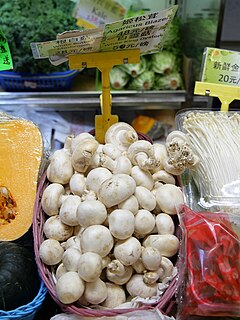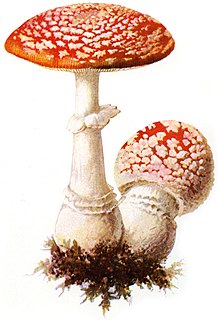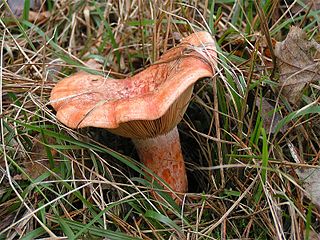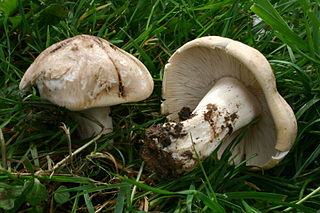
A mushroom or toadstool is the fleshy, spore-bearing fruiting body of a fungus, typically produced above ground, on soil, or on its food source.

Edible mushrooms are the fleshy and edible fruit bodies of several species of macrofungi. They can appear either below ground (hypogeous) or above ground (epigeous) where they may be picked by hand. Edibility may be defined by criteria that include absence of poisonous effects on humans and desirable taste and aroma. Edible mushrooms are consumed for their nutritional and culinary value. Mushrooms, especially dried shiitake, are sources of umami flavor.

The genus Amanita contains about 600 species of agarics, including some of the most toxic known mushrooms found worldwide, as well as some well-regarded edible species. This genus is responsible for approximately 95% of the fatalities resulting from mushroom poisoning, with the death cap accounting for about 50% on its own. The most potent toxin present in these mushrooms is α-amanitin.

Mushroom hunting, mushrooming, mushroom picking, mushroom foraging, and similar terms describe the activity of gathering mushrooms in the wild, typically for culinary use. This practice is popular throughout most of Europe, Australia, Japan, Korea, parts of the Middle East, and the Indian subcontinent, as well as the temperate regions of Canada and the United States.

Lactarius deliciosus, commonly known as the saffron milk cap and red pine mushroom, is one of the best known members of the large milk-cap genus Lactarius in the order Russulales. It is found in Europe and has been accidentally introduced to other countries under conifers and can be found growing in pine plantations. A fresco in the Roman town of Herculaneum appears to depict Lactarius deliciosus and is one of the earliest pieces of art to illustrate a fungus.

Around 750 worldwide species of ectomycorrhizal mushrooms compose the genus Russula. They are typically common, fairly large, and brightly colored – making them one of the most recognizable genera among mycologists and mushroom collectors. Their distinguishing characteristics include usually brightly coloured caps, a white to dark yellow spore print, brittle, attached gills, an absence of latex, and absence of partial veil or volva tissue on the stem. Microscopically, the genus is characterised by the amyloid ornamented spores and flesh (trama) composed of spherocysts. Members of the related genus Lactarius have similar characteristics but emit a milky latex when their gills are broken. The genus was described by Christian Hendrik Persoon in 1796.

Tricholoma is a genus of fungus that contains many fairly fleshy white-spored gilled mushrooms which are found worldwide generally growing in woodlands. These are ectomycorrhizal fungi, existing in a symbiotic relationship with various species of coniferous or broad-leaved trees. The generic name derives from Ancient Greek: τριχο-, romanized: tricho-, lit. 'hair' and Ancient Greek: λῶμα, romanized: loma, lit. 'fringe, border' although only a few species have shaggy caps which fit this description.

Inocybe erubescens, also known as I. patouillardii, commonly known as the deadly fibrecap, brick-red tear mushroom or red-staining Inocybe, is a poisonous basidiomycete fungus, one of many in the genus Inocybe and one of the few known to have caused death. It is found growing in small groups on leaf litters in association with beech. All mushroom guidebooks as well as the mushroomers advise that the entire genus should be avoided. The fruit bodies appear in spring and summer; the bell-shaped caps are generally pale pinkish in colour with red stains, with a reddish-pink stipe and gills.

Calocybe gambosa, commonly known as St. George's mushroom, is an edible mushroom that grows mainly in fields, grass verges and roadsides. Deriving its common name from when it first appears in the UK, namely on St George's Day. It appears in March in Italy, a warmer country where it is also a popular mushroom to eat, and is known there as "prugnolo",marzolino. It is also popular in Northern Spain and Southern France, in the Basque Country region and its surroundings where it appears in April. In these regions it is usually eaten sautéed with egg or with bacon.

Entoloma sinuatum is a poisonous mushroom found across Europe and North America. Some guidebooks refer to it by its older scientific names of Entoloma lividum or Rhodophyllus sinuatus. The largest mushroom of the genus of pink-spored fungi known as Entoloma, it is also the type species. Appearing in late summer and autumn, fruit bodies are found in deciduous woodlands on clay or chalky soils, or nearby parklands, sometimes in the form of fairy rings. Solid in shape, they resemble members of the genus Tricholoma. The ivory to light grey-brown cap is up to 20 cm (7.9 in) across with a margin that is rolled inward. The sinuate gills are pale and often yellowish, becoming pink as the spores develop. The thick whitish stem has no ring.

Suillus granulatus is a pored mushroom of the genus Suillus in the family Suillaceae. It is similar to the related S. luteus, but can be distinguished by its ringless stalk. Like S. luteus, it is an edible mushroom that often grows in a symbiosis (mycorrhiza) with pine. It has been commonly known as the weeping bolete, or the granulated bolete. Previously thought to exist in North America, that species has now been confirmed to be the rediscovered Suillus weaverae.

Agaricus campestris is a widely eaten gilled mushroom closely related to the cultivated button mushroom Agaricus bisporus. It is commonly known as the field mushroom or, in North America, meadow mushroom.

Lactarius rubrilacteus is a species of mushroom of the genus Lactarius. It is also known as the bleeding milkcap, as is at least one other member of the genus, Lactarius deliciosus.

Inocybe geophylla, commonly known as the earthy inocybe, common white inocybe or white fibercap, is a poisonous mushroom of the genus Inocybe. It is widespread and common in Europe and North America, appearing under both conifer and deciduous trees in summer and autumn. The fruiting body is a small all-white or cream mushroom with a fibrous silky umbonate cap and adnexed gills. An all-lilac variety lilacina is also common.

Lactifluus volemus, formerly known as Lactarius volemus, is a species of fungus in the family Russulaceae. It is widely distributed in the northern hemisphere, in temperate regions of Europe, North America and Asia as well as some subtropical and tropical regions of Central America and Asia. A mycorrhizal fungus, its fruit bodies grow on the ground at the base of various species of trees from summer to autumn, either individually or in groups. It is valued as an edible mushroom, and is sold in markets in Asia. Several other Lactifluus mushrooms resemble L. volemus, such as the closely related edible species L. corrugis, but these can be distinguished by differences in distribution, visible morphology, and microscopic characteristics. L. volemus produces a white spore print and has roughly spherical spores about 7–8 micrometres in diameter.

Grifola frondosa is a polypore mushroom that grows at the base of trees, particularly oaks. It is typically found in late summer to early autumn. It is native to China, Europe, and North America.

The Lyophyllaceae is a family of fungi in the order Agaricales. A 2008 estimate indicated eight genera and 157 species; as of November 2014, the Catalog of Life lists 13 genera in the family. Lyophyllaceae was circumscribed by mycologist Walter Jülich in 1981.

Macrocybe is a genus of fungi in the family Tricholomataceae. The genus contains seven species, widely distributed in tropical regions worldwide.

Lactifluus corrugis, commonly known as the corrugated-cap milky, is an edible species of fungus in the family Russulaceae. It was first described by American mycologist Charles Horton Peck in 1880.
Calocybe indica, commonly known as the milky white mushroom, is a species of edible mushroom native to India. The sturdy all-white mushrooms appear in summer after rainfall in fields and on road verges. Traditionally eaten in West Bengal, it is being grown commercially in several Indian states and other tropical countries.



















